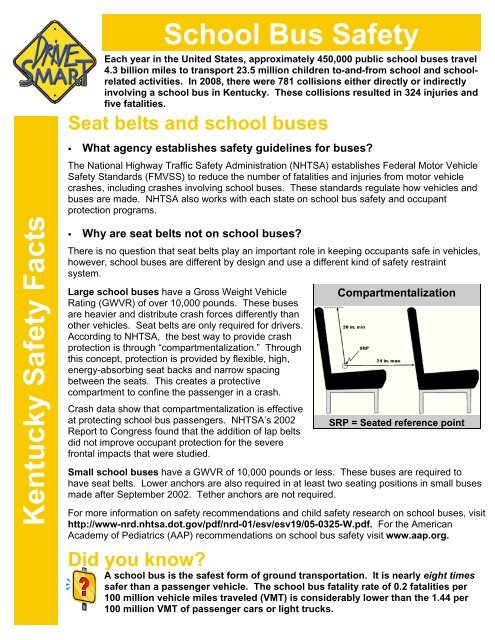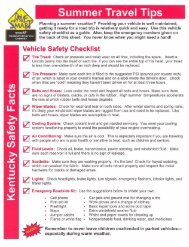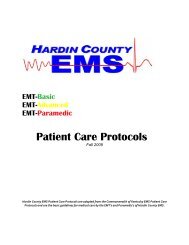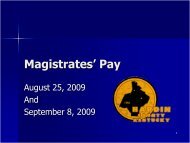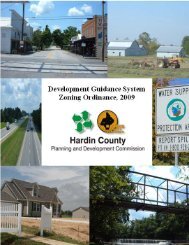School Bus Safety Kentucky Safety Facts
School Bus Safety Kentucky Safety Facts
School Bus Safety Kentucky Safety Facts
- TAGS
- kentucky
You also want an ePaper? Increase the reach of your titles
YUMPU automatically turns print PDFs into web optimized ePapers that Google loves.
<strong>Kentucky</strong> <strong>Safety</strong> <strong>Facts</strong><strong>School</strong> <strong>Bus</strong> <strong>Safety</strong>Each year in the United States, approximately 450,000 public school buses travel4.3 billion miles to transport 23.5 million children to-and-from school and schoolrelatedactivities. In 2008, there were 781 collisions either directly or indirectlyinvolving a school bus in <strong>Kentucky</strong>. These collisions resulted in 324 injuries andfive fatalities.Seat belts and school buses• What agency establishes safety guidelines for buses?The National Highway Traffic <strong>Safety</strong> Administration (NHTSA) establishes Federal Motor Vehicle<strong>Safety</strong> Standards (FMVSS) to reduce the number of fatalities and injuries from motor vehiclecrashes, including crashes involving school buses. These standards regulate how vehicles andbuses are made. NHTSA also works with each state on school bus safety and occupantprotection programs.• Why are seat belts not on school buses?There is no question that seat belts play an important role in keeping occupants safe in vehicles,however, school buses are different by design and use a different kind of safety restraintsystem.Large school buses have a Gross Weight VehicleRating (GWVR) of over 10,000 pounds. These busesare heavier and distribute crash forces differently thanother vehicles. Seat belts are only required for drivers.According to NHTSA, the best way to provide crashprotection is through “compartmentalization.” Throughthis concept, protection is provided by flexible, high,energy-absorbing seat backs and narrow spacingbetween the seats. This creates a protectivecompartment to confine the passenger in a crash.Crash data show that compartmentalization is effectiveat protecting school bus passengers. NHTSA’s 2002Report to Congress found that the addition of lap beltsdid not improve occupant protection for the severefrontal impacts that were studied.CompartmentalizationSRP = Seated reference pointSmall school buses have a GWVR of 10,000 pounds or less. These buses are required tohave seat belts. Lower anchors are also required in at least two seating positions in small busesmade after September 2002. Tether anchors are not required.For more information on safety recommendations and child safety research on school buses, visithttp://www-nrd.nhtsa.dot.gov/pdf/nrd-01/esv/esv19/05-0325-W.pdf. For the AmericanAcademy of Pediatrics (AAP) recommendations on school bus safety visit www.aap.org.Did you know?A school bus is the safest form of ground transportation. It is nearly eight timessafer than a passenger vehicle. The school bus fatality rate of 0.2 fatalities per100 million vehicle miles traveled (VMT) is considerably lower than the 1.44 per100 million VMT of passenger cars or light trucks.


